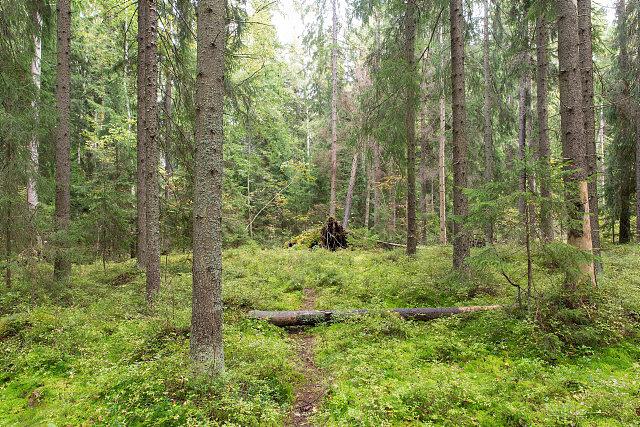
In a joint PPP project between Luke and five cities, the effects of forest management on the diversity of urban forests were studied
On this page
Urban forests are vital natural areas with diverse species. Various tree species, as well as trees of different sizes and ages, provide valuable habitats for numerous species. In a joint project between the Natural resources institute Finland (Luke) and cities in Southern Finland, the effects of forest management on tree regeneration, soil microbiota, and the diversity of decay fungi were studied.


The management of urban forests is delicate, aiming to preserve recreational, landscape, and biodiversity values. Branches are cleared from paths, and individual trees are felled, for example, for safety reasons. In Luke's PPP project with five cities, called TAMO (Biodiversity in Urban Forests), the effects of forest management on urban forest biodiversity were studied.
"Urban forests are important areas of biodiversity. They host, for instance, endangered fungal species," says Leena Hamberg, project manager and senior scientist at Luke. "Urban forests have minor economic expectations and, in some cases, no expectations at all, especially in Southern Finland. They are managed for the residents, as recreational environments."
Decayed wood plays a significant role in urban forests.
TAMO is a Public-Private Partnership (PPP) project funded jointly by Luke and the participating cities. In PPP projects, the funders and Luke prepare research questions together.
The project's research found that the regeneration of light-demanding trees, such as birches, in spruce-dominated forests requires a reasonably open canopy. Conversely, the regeneration of spruces and their sapling development can be supported in urban forests by preserving thickets.
According to the studies, slight management of urban forests does not significantly affect forest soil or substantially influence tree regeneration. However, diversifying the tree species composition can enhance biodiversity in the area by increasing the richness of fungal symbionts associated with tree roots.
Decomposing wood of different sizes complements each other from a biodiversity perspective. Decay wood serves as a substrate for fungi and as a habitat for many beetles, for example.
Even small-diameter decay wood, such as dead branches, is crucial for endangered species. For instance, endangered polypore fungi were found on spruce branches. Fallen branches of deciduous trees, on the other hand, hosted endangered fungi and bracket fungi. According to Hamberg, thin branches are not optimal substrates for producing fungal fruiting bodies, but fungi can presumably spread from branches to tree trunks. Therefore, small-diameter decay wood, alongside large-diameter decay wood, is significant for biodiversity.
The project's results as part of forest management decision-making
The project produced information on the role of urban forests as biodiversity maintainers and the importance of forest management measures for the diversity of different species groups. This information can be utilized in municipal forest management decision-making.
"Forest management decisions should always be based on scientific facts rather than opinions. Forest management is done over the long term," emphasizes Anna-Maaria Särkkä, the forest manager of the city of Lahti.
Särkkä says that Lahti's urban forests use shelterwood silviculture methods, and the intensity of thinning has been slight, leading to the strengthening of spruce understory at the expense of deciduous trees. "The project has provided us with a basis for planning new management measures. When thinning spruce stands, we take the project's research results into account on adequate thinning intensity to allow light-demanding trees to regenerate."
The logging residues have been a significant cost for the city of Lahti when removing, for example, small-diameter decay wood from forests. According to Särkkä, the project provided confirmation that more decay wood can be left in the city's forests, reducing costs and enhancing forest biodiversity.
Tamo project (Biodiversity in Urban Forests)
Project duration:
1st of January 2022- 31st of December 2024
Funders:
Natural resources institute Finland
City of Espoo
City of Helsinki
City of Lahti
City of Tampere
City of Vantaa
What is a Public Private Partnership (PPP) project?
PPP projects are pre-competitive research initiatives closely linked to Luke's strategy as well as the future needs of society and business.
Luke and several companies along the value chain and other organizations participate in the financing of the project together. The project can be initiated swiftly, with research targeted at the specific questions at hand.
During the planning phase of the project, Luke and the companies collaborate to prepare the research questions.
Luke owns the results generated by the project and seeks to protect results important for industry before publication. Participating companies have preferential negotiation rights to the results and inventions.
Luke conducts the research following good scientific practices and research ethics principles, and publishes the results.
